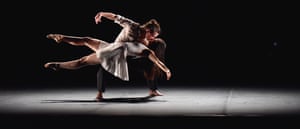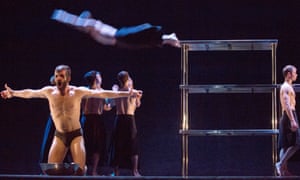[ad_1]
Angelin Preljocaj is celebrated for his precision engineered choreography, but there is one move he can’t quite control: the extreme hair flick. “I try to choreograph hair – it’s not so easy,” he says, laughing down the phone from Aix-en-Provence, home to his company for more than 20 years. “It’s funny how hair can extend the movement of the body in a sequence, but it’s also hazardous. There is something that occurs that is … unexpected. But that is very nice.”
The choreography of his dancers’ glossy locks, as well as their limbs, is essential to Preljocaj’s 2016 piece La Fresque, which has its UK premiere at Sadler’s Wells in London this month. It is based on a traditional Chinese tale about a traveller who discovers a painting on the wall of a temple, enters the world of the picture and weds one of the five women it depicts before crashing back to reality. When he looks back at the image on the wall, he discovers that the woman’s hair, which once flowed freely, is now fixed in a chignon symbolising that she is indeed married.

La Fresque opens with a stunning lighting configuration by designer Eric Soyer, which suggests a storm encountered by the traveller. In fact, says Preljocaj, “what you see at the very beginning is a lock of hair floating”. These long, ghostly strands twist into a pulsing, knotty mass that the travellers pass through. When the women in the painting first appear their bodies are intertwined – almost plaited together – but in a sequence that thrums to the electro score of Air’s Nicolas Godin, they shake themselves free with shockheaded moves that send their tresses flying. It makes the fidgety hair-flickers of Rosas Danst Rosas look positively languid.
In a later scene, Preljocaj’s dancers are suspended midair, wrapped around circus ropes that resemble braids. And in one sequence, with a seductive mystery characteristic of his creations, four women revolve around the betrothed, twisting her hair as if holding maypole ribbons, before pinning it into a bun.
Aside from works such as his Orwellian Romeo and Juliet and a Snow White that paired Mahler’s music with outre Gaultier outfits, Prelojcaj usually favours the abstract over a narrative. But one constant is his preoccupation with the sort of nuanced rituals seen in La Fresque. “Dance itself is a ritual in essence,” he says. “Each time you have people dancing, whatever the performance, it is a kind of ritual. There is something sacred about it. Dance is showing the soul with your body.”

The apotheosis of this for Preljocaj, who has made pieces about both the apocalypse and the annunciation, is perhaps his disquieting 2001 creation MC 14/22 (Ceci Est Mon Corps), its title reflecting the chapter and verse of St Mark’s Gospel relating the Last Supper (“Take it, this is my body”). In one memorable trance-like ceremony, the 12 apostle-dancers take turns flinging themselves off a platform, to be caught by the others below before returning to jump once more.
Preljocaj defines choreography as creating a house that he invites dancers to live in. “Without them,” he says, “it is an empty house without mood or thoughts.” Constructing the house for La Fresque began when the Théâtre de la Ville in Paris asked him to make a piece for a young audience. He read a number of fairytales from around the world before settling on the Chinese one. “This tale from the 14th century is so actuel,” he says, in its blurring of reality and virtuality. “This is exactly what happens today with the young audience.” He gives the example of Pokémon Go, the hit game created by augmented reality specialist Niantic Inc.
As a child, it was judo that first excited Preljocaj. He was raised in a suburb of Paris where he had been born to political refugees from Albania. “Dance wasn’t in the culture of my family,” he says. When a girl at school showed him a photograph of Rudolf Nureyev, he was entranced. “It may seem strange to fall in love with dance through a fixed image. It’s paradoxical. But it was so wonderful and light and inspirational. I was maybe eight or nine. I thought: what is this art that can make somebody so illuminated?”

His schoolfriend gave him the address of her ballet class and he turned up in his judo kit. He was the only boy at the barre. “It was very strange but nice,” he says. However, he was teased by the other boys in the neighbourhood. “This was before hip-hop and other kinds of dance. Ballet was something very strange to them.” Did it upset him? “Sometimes this adversity helps you to be stronger.”
When Merce Cunningham presented a series of free events at the Pompidou Centre, Preljocaj went along and “discovered something incredible: a universe of ways of moving”. He moved to New York and in 1980 danced with Cunningham, who taught him a valuable lesson. “One day, Merce stopped a class, a little disappointed and angry. He said, ‘Stop showing me the movement, just do the movement.’ You see a lot of dancers show the movement – they’re not fully involved in the physical sensation.”

Preljocaj has now choreographed about 50 works. His latest, set to Schubert’s Die Winterreise, will be staged this month at the Pavillon Noir, his company’s Aix HQ, which is built to accommodate the entire creative process, from workshops and rehearsals to public performance. Soon after, he’ll arrive in London with La Fresque, which is part of an ambitious project, FranceDance UK, presented by the Institut Français.
The four-month festival has cities around the UK hosting performances by French and France-based dance talent. It runs until mid-November, by which time – perhaps – these two countries will no longer be dance partners in the EU. For Preljocaj, Brexit is “an artistic catastrophe” but the festival – and the diverse company of dancers in La Fresque – strikes an optimistic note about creative collaboration during a divisive political period.
La Fresque has been staged around the world and I wonder if, like the spectator in the temple, each audience has in a strange way left their own mark on this artwork. After all, a performance and a crowd can have a transformative effect on each other. Preljocaj agrees. “The audience always gives a particular touch to a performance,” he acknowledges. “Marcel Duchamp used to say that it is the spectator that also made the art.”
• La Fresque is at Sadler’s Wells, London, 30 September to 2 October. FranceDance UK runs until 12 November.
[ad_2]
READ SOURCE






